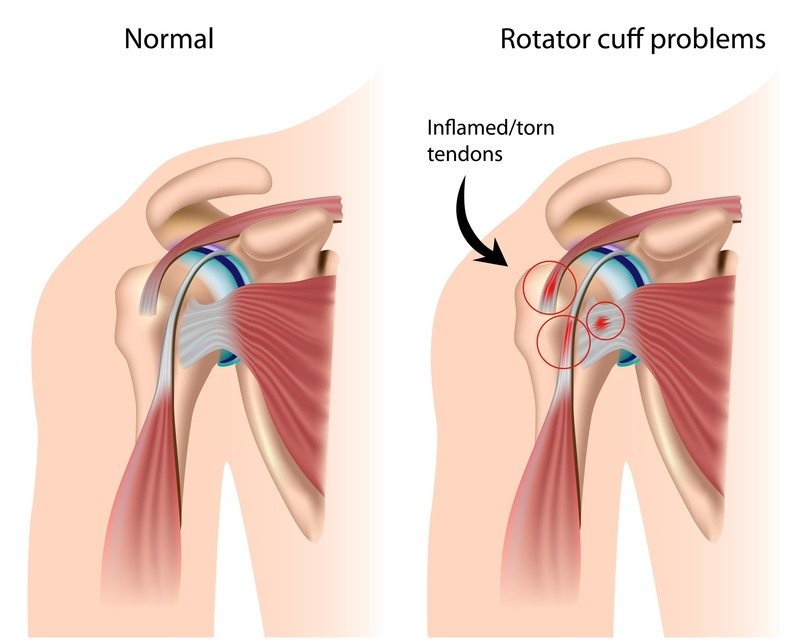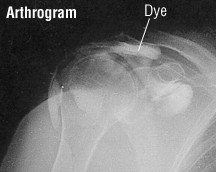Rotator cuff injury
Medically reviewed by Drugs.com. Last updated on Dec 1, 2023.
What is a Rotator cuff injury?

Four tendons attach muscles from the shoulder blade and ribs to the upper arm bone (humerus). Because these tendons help to rotate the arm within its socket, this sleeve of tendons is called the rotator cuff.
|
|
Tendons in the rotator cuff can be injured easily because they move within a tight space. When the shoulder is turned or lifted at the limit of its natural range of movement, the tendons in this tight space are moved, too. Occasionally, the rotator cuff tendons can bump or rub against a bony knob (the acromion) above them or against a ligament at the front of the shoulder.
This friction is known as impingement syndrome and causes inflammation in the rotator cuff. Rotator cuff friction is most likely to cause inflammation if your shoulder movement is rough or repetitive. Inflammation can cause three problems:
- Rotator cuff tendonitis — Inflammation of a single tendon causes pain only during specific movements, when the muscle that pulls against that tendon is being used or when you are reaching upwards.
- Shoulder bursitis, also called subacromial bursitis — Bursitis occurs when inflammation spreads into the pocket of fluid that lubricates the rotator cuff tendons. Pain is often worse at night and occurs when you move your shoulder in almost any direction, particularly if you are reaching upwards.
- Rotator cuff tear — The tendon may tear after it has been weakened by inflammation.
|
|
Several types of shoulder use commonly trigger rotator cuff injury:
- Pushing off with your arms — People with arthritis of the knee, other painful conditions in the legs, or weak quadriceps muscles in the thighs often compensate by pushing off with their arms when they rise from a chair. During the push off, the shoulder's socket and humerus function like an upside-down mortar and pestle, crushing and grinding the rotator cuff tendons. Falls onto an outstretched arm, head-on automobile accidents and sports collisions also can crush the tendons.
- Repetitive reaching — Overhead arm positions narrow the tight space that the rotator cuff tendons must pass through. Pushups, pitching a baseball, swimming, house painting, filing, building construction, auto mechanic work and other activities can cause injury of the rotator cuff.
- Forceful or abrupt overhead arm movements — Tears are particularly common in athletes in throwing sports, racquet sports and wrestling. Abrupt movements, such as pulling to start a lawn mower, can tear a weakened tendon.
In addition, your shoulder can be injured more easily if it is out of shape. The narrow space that envelops the rotator cuff tendons becomes even narrower if your shoulder muscles are weakened or tight. When this happens, routine shoulder movements are more likely to cause tendon friction.
Symptoms
Rotator cuff injuries cause pain in your shoulder and upper arm. The pain may be most noticeable when you reach up or out. When you turn your arm as you lift it, the tendons are more likely to rub against surrounding structures. For this reason your shoulder symptoms may be worst when you try to comb your hair or slip your arm into a sleeve. You also may have dull, aching shoulder pain at night.
Rotator cuff tears that affect a significant portion of the tendon cause weakness of the shoulder, limiting your ability to hold your arm out to one side or to lift an object. Difficulty using the shoulder because of pain does not always mean that there is a tear. Rotator cuff injuries cause pain in your shoulder and upper arm. The pain may be most noticeable when you reach up or out. When you turn your arm as you lift it, the tendons are more likely to rub against surrounding structures. For this reason your shoulder symptoms may be worst when you try to comb your hair or slip your arm into a sleeve. You also may have dull, aching shoulder pain at night.
Rotator cuff tears that affect a significant portion of the tendon cause weakness of the shoulder, limiting your ability to hold your arm out to one side or to lift an object. Difficulty using the shoulder because of pain does not always mean that there is a tear.
Diagnosis
A rotator cuff injury usually is diagnosed by physical examination. Your doctor will rotate your arm at the shoulder and then will raise your arm. If this type of motion causes pain, the rotator cuff may be inflamed.
If you have noticeable weakness, you may need further testing to check for a rotator cuff tear. Your doctor may inject a numbing medicine into your shoulder to help distinguish actual weakness of the tendon from your muscle "giving way" because of pain.
If a tear is suspected, a magnetic resonance imaging (MRI) scan can confirm the diagnosis. An alternative diagnostic test is a shoulder arthrogram. An arthrogram is an X-ray of a joint following injection of dye into the joint. Because MRIs provide excellent pictures without putting a needle into a joint, arthrograms are done less frequently today.
|
|
Shoulder X-rays are not always needed, but may be helpful if you have had trauma to the shoulder or if your doctor cannot move your shoulder through its full range of motion. Another reason to do a shoulder X-ray is too look for calcium deposits in or around the shoulder. Calcium deposits form on a persistently inflamed tendon, causing a condition called calcific tendonitis.
Expected duration
Without proper treatment, symptoms of a rotator cuff injury or tear can persist for months or years, and usually become worse over time. Most rotator cuff injuries respond to treatment within four to six weeks, especially if an injection is part of the treatment.
Prevention
In many cases, a rotator cuff injury can be avoided. To avoid reaching over your head repeatedly, use a step stool or ladder during projects. Avoid using your arms to push off from a chair. For people who are in poor athletic shape or who have arthritis in the knees, exercises to strengthen the quadriceps muscles in the thighs can be very helpful, so that it is not necessary for you to use your arms to get up from sitting.
People who are dependent on their arms to rise out of a chair can raise the seat of their favorite chair with a thick folded blanket or a short platform to make it easier to get up.
Exercises that strengthen the rotator cuff muscles also are an important part of prevention. Some of the rotator cuff muscles pull down on the upper arm bone as they work, widening the space that the tendons travel through. Physical therapy that strengthens the rotator cuff muscles can make your shoulder less vulnerable to injury.
Treatment
Tendonitis, bursitis and small rotator cuff tears in the shoulder can be treated effectively with an injection of a corticosteroid medicine followed by physical therapy exercises to restore shoulder movement and strengthen the rotator cuff muscles. Nonsteroidal anti-inflammatory drugs (NSAIDs) such as ibuprofen (Advil, Motrin and others) are useful to decrease pain and inflammation.
If your doctor determines that you have calcific tendonitis (calcium deposits), other treatments may be helpful. There is some evidence that treatment of the shoulder with ultrasound or a procedure called lithotripsy, which uses powerful ultrasound waves known as shock waves, may help to break up calcium deposits and speed healing.
Surgery may be necessary for frequently recurring rotator cuff injuries or large tears in a rotator cuff tendon. Either arthroscopy (camera-assisted surgery) or traditional open surgery can be used.
When to call a professional
A doctor should evaluate shoulder symptoms that last for more than one week.
Prognosis
People with a rotator cuff injury typically recover well with treatment. However, it's common to injure the same shoulder again, especially if you do not change the way you use your shoulder. Elderly people are prone to rotator cuff problems and have a harder time recovering because their shoulders have a less robust blood supply.
Additional info
National Institute of Arthritis and Musculoskeletal and Skin Diseases
https://www.niams.nih.gov/
American Academy of Orthopaedic Surgeons (AAOS)
https://www.aaos.org/
National Athletic Trainers' Association
https://www.nata.org/
American Orthopedic Society for Sports Medicine
https://www.sportsmed.org/
Further information
Always consult your healthcare provider to ensure the information displayed on this page applies to your personal circumstances.



